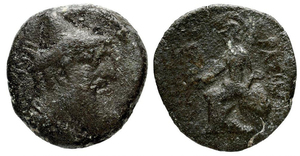Xerxes c.215-202 BC (Kov 17-20)
Description
Xerxes's (BNP [3]) ancestry is unknown. Though usually called king of Sophene by modern historians, Grabowski (2011, 132) has noted that Polybius (Pol. 8,23) refers to him as the ruler of the city Armosata (= Arsamosata in Sophene). His reign was interrupted by an invasion of the Seleucid king Antiochus III in 212 BC. The siege of Arsamosata ended with an agreement for Xerxes to pay a reduced tribute, and marry Antiochus's sister, Antiochis. Xerxes was eventually murdered by Antiochis at her brother's order. (BNP 15, 838).
Xerxes's coins are notable as the first of Sophene to bear control marks. These controls are also found on the coins of Antiochus III attributed to the mint of Seleucia ad Calycadnum (SC 1017), and suggest that Xerxes's coins were produced there under Seleucid authority.
Kovacs, Frank L. “Armenian Coinage in the Classical Period” CNS 10, Classical Numismatic Group, Lancaster, 2016, pp. 3.
Xerxes's coins are notable as the first of Sophene to bear control marks. These controls are also found on the coins of Antiochus III attributed to the mint of Seleucia ad Calycadnum (SC 1017), and suggest that Xerxes's coins were produced there under Seleucid authority.
Kovacs, Frank L. “Armenian Coinage in the Classical Period” CNS 10, Classical Numismatic Group, Lancaster, 2016, pp. 3.




